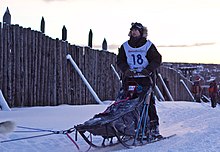Adog sledordog sleigh[1]is asledpulled by one or moresled dogsused to travel overiceand through snow. Numerous types of sleds are used, depending on their function. They can be used fordog sled racing.Traditionally inGreenlandand the eastern CanadianArctictheInuithad the dogs pull in a fan shape in front of the sled, while in other regions, such asAlaskaand the western part ofNorthern Canadathe dogs pull side by side in pairs.

History
editDog power has been used for hunting and traveling for over a thousand years. As far back as the 10th century CE these dogs have contributed to human culture.[2]
Assembling a dog sled team involves picking lead dogs, point dogs, swing dogs, and wheel dogs. The lead dog is crucial, somusherstake extraordinary care of these dogs. Another important detail is to have powerful wheel dogs to pull the sled out from the snow. Point dogs (optional) are located behind the leader dogs, swing dogs between the point and wheel dogs, and team dogs are all other dogs in between the wheel and swing dogs and are selected for their endurance, strength, and speed as part of the team. In dog sledding,Siberian HuskiesorAlaskan Malamutesare the main types of dogs that are used for recreational sledding because of their strength, speed, and endurance as well as their ability to withstand the cold. However,Alaskan Huskiesare also a popular dog forsled dog racing,because of their endurance, good eating habits, speed, and dedication to running even when tired.[3]
Sometimes, for sprint races, mushers use short-haired hounds that are faster than the averagehusky.These hounds are raised from a young age to pull. It is harder to train hounds than it is to train Siberian Huskies and Malamutes to pull a sled because it is not in their nature.
In some situations, some Indigenous peoples' tribes would eat the dogs they had either because they were not useful, or if the sledder needed food.[1][citation needed]
See also
editReferences
edit- ^"Collins 2012 digital dictionary".Retrieved3 December2014.
- ^Swan, Thom."Early Sled Dog History".Swanny's Place.Archived fromthe originalon 17 June 2009.Retrieved17 October2013.
- ^"Do many Siberian Huskies run the Iditarod? If not, why?".12 October 2020.
4.[2]